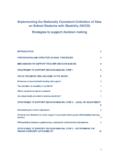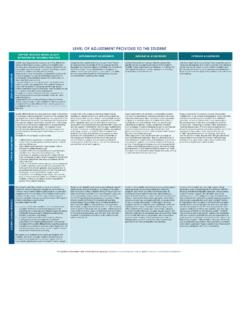Transcription of Case Study matrix Age/Type of Disability Adjustment
1 Nationally Consistent Collection of Data on School Students with Disability case Study matrix Age/Type of Disability Category Level of Adjustment case Study 1 Catherine is a year 4 student with anaphylaxis in relation to all nut and dairy products. Physical QDTP case Study 2 Jonathon is a year 1 student and his speech is sometimes difficult to understand. Cognitive Supplementary case Study 3 Frank is a 15-year-old boy with a diagnosis of duchenne muscular dystrophy . Physical Substantial case Study 4 Tristan is 16 years old with severe intellectual Disability and autism.
2 Cognitive Extensive case Study 5 Kyle is 16 years old and has generalised anxiety disorder. Social/emotional QDTP case Study 6 Ella is a year 1 student and has anaphylaxis to peanuts and shellfish. Physical QDTP case Study 7 Eddy is a year 7 student with cerebral palsy. Physical QDTP case Study 8 Billy is a year 3 student working approximately two years behind grade level in most areas. Not applicable Not applicable case Study 9 Jayden and Connor are both year 2 students. Jayden has been diagnosed with a mild intellectual Disability while Connor s parents have chosen not to have him assessed.
3 Cognitive Supplementary case Study 10 John is a pre-primary aged student and who has sensory processing issues. His mother does not want him to be referred to Child and Adolescent Mental Health Services. Social/emotional Supplementary case Study 11 Aaron is a year 10 student and his Disability is yet to be diagnosed. Not applicable Not applicable case Study 12 Joseph is a year 2 student with a diagnosis of dysgraphia. Cognitive Supplementary case Study 13 Charlotte is a year 9 student and is diagnosed as having Type 1 diabetes.
4 Physical Supplementary case Study 14 Tara is a year 11 student and has a confirmed diagnosis of moderate intellectual Disability . Cognitive Substantial case Study 15 Andrew is a year 11 student and was diagnosed with major depression, generalised anxiety and obsessive compulsive disorder. Social/emotional Substantial case Study 16 Daniel is a year 10 student with duchenne muscular dystrophy . Physical Substantial case Study 17 Zac is a 6 year old boy with Cerebral Palsy. Physical Extensive case Study 18 Russell is a year 10 student who was diagnosed with dyslexia.
5 Cognitive Supplementary case Study 19 Jamie is a year 12 student with a social/emotional condition. Social/emotional Extensive case Study 20 Tyra is a year 6 student who was diagnosed with generalised anxiety disorder. Social/emotional Substantial Nationally Consistent Collection of Data on School Students with Disability Age/Type of Disability Category Level of Adjustment case Study 21 Rosie is a year 10 student who is profoundly deaf. Sensory Substantial case Study 22 Alistair is a year 9 student who is profoundly deaf.
6 Sensory Extensive case Study 23 Gemma is a year 4 student who was diagnosed with anaphylaxis in relation to all nut and dairy products. Physical QDTP case Study 24 Liam is a year 9 student. He wears hearing aids as a result of his diagnosis with a mild sensorineural hearing loss. Sensory QDTP case Study 25 James is a year 1 student who requires further evaluation into his learning and communication difficulties. Cognitive Supplementary case Study 26 Cindy is a year 10 student diagnosed with Asperger s Syndrome. Social/emotional Supplementary case Study 27 George is an eight year-old boy diagnosed with Down syndrome and kidney disease.
7 Cognitive Substantial case Study 28 Sam is a 16-year-old boy with a diagnosis of duchenne muscular dystrophy . Physical Substantial case Study 29 Jane is a six-year-old girl with a diagnosis of cerebral palsy and severe intellectual Disability . Cognitive Extensive case Study 30 William is a 16-year-old boy with a diagnosis of severe intellectual Disability and autism spectrum disorder. Cognitive Extensive case Study 31 John is a year 6 student who has recently displayed signs of anxiety. Social/emotional/excluded from NCCD QDTP/excluded from NCCD case Study 32 A number of students at a P-12 school have asthma.
8 Physical/excluded from NCCD QDTP/excluded from NCCD case Study 33 Max is a year 2 student with an undiagnosed learning Disability . Cognitive/excluded from NCCD QDTP/excluded from NCCD case Study 34 Mary is an 11 year old who has a social/emotional Disability (anxiety and/or depression). Social/emotional Substantial case Study 35 Hassan is a 10 year old boy who has a cognitive Disability (anxiety and a lack of control and feeling of safety). Cognitive Supplementary Nationally Consistent Collection of Data on School Students with Disability Hypothetical case Study Catherine Catherine is a year 4 student at a small remote primary school.
9 Catherine has been diagnosed with anaphylaxis in relation to all nut and dairy products. She has had one anaphylactic episode while at home in the last 12 months, which required her to be transported to hospital overnight after her parents administered adrenalin via an auto-injector. During Catherine s enrolment, her school called a case conference attended by her parents, who provided a healthcare plan from her GP. Catherine s teacher spoke to her doctor by telephone to confirm the details of the healthcare plan. During the initial case conference with the principal, Catherine s classroom teacher and her parents, it was agreed that all staff would participate in 6-monthly training, with all new staff trained within 6 weeks of arrival, and an annual review of the healthcare plan ensuring all contact numbers and details are up to date.
10 It was also agreed that the school would take part in annual drills implementing the emergency response plan. Catherine s parents committed to providing the school with medical updates as soon as was reasonably possible if her condition changed. They would also provide two new auto-injectors every 6 months. During the class health lessons, Catherine s teacher has talked about what anaphylaxis is and what it means for Catherine. Her mother has also come to the health lessons and talked about the alternative foods that Catherine eats and what things she needs to do to avoid a reaction.








